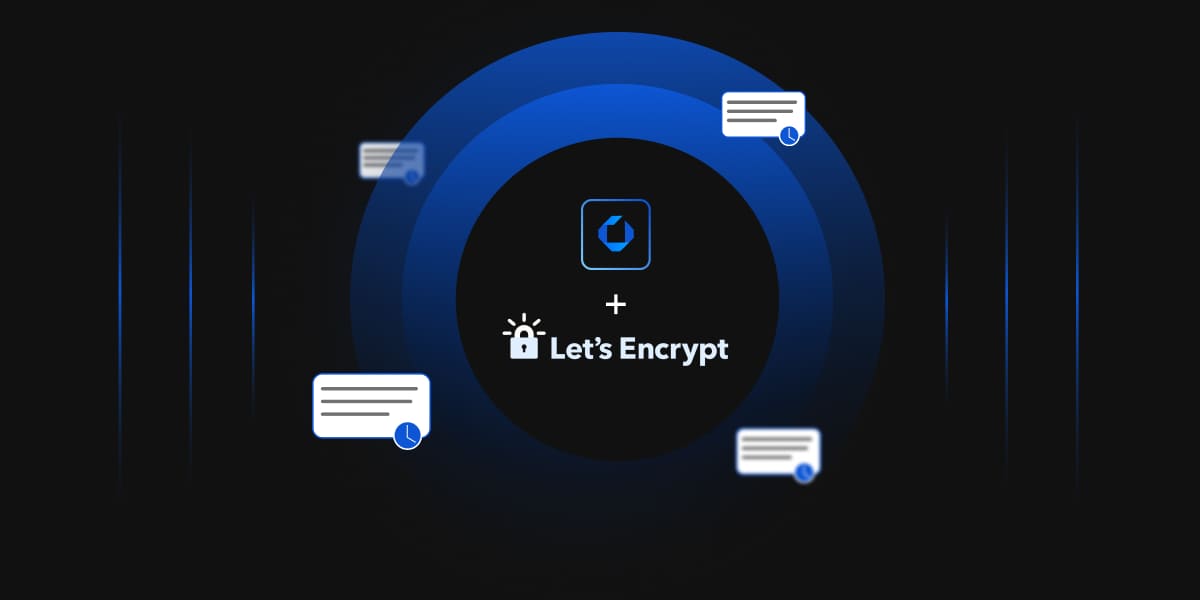- What is Certificate Lifecycle Management?
- Why CLM Matters in Enterprise Security?
- Key Components of an Effective CLM Strategy
- Challenges in Certificate Lifecycle Management
- Benefits of Implementing CLM
- Future of CLM: AI and Machine Learning
- How Could Encryption Consulting Help?
- Benefits for Enterprises
- Conclusion
Digital Trust is foundational to enterprise operations, and the management of digital certificates has become a mission-critical task. Certificates are the backbone of secure communications, enabling encryption, authentication, and data integrity across networks, applications, and devices.
However, the landscape is rapidly evolving. In 2022, Google announced a move toward 90-day certificate validity for public TLS certificates, citing the need for enhanced agility and reduced exposure to compromised keys. This shift is part of a broader industry trend toward shorter certificate lifespans, which, while improving security, also significantly increases the operational burden on organizations.
On 11 Apr 2025, the CA/Browser Forum voted for and approved Ballot SC-081v3, a proposal led by Apple to shorten the lifespan of SSL/TLS certificates progressively over the next few years, culminating in a maximum lifespan of 47 days by 2029. Without automation and centralized oversight, this frequency can easily lead to missed renewals, expired certificates, and service outages.
These developments underscore the critical need for Certificate Lifecycle Management, a structured, automated approach to managing certificates throughout their lifecycle. CLM not only helps prevent costly outages and security breaches but also ensures compliance, operational efficiency, and alignment with modern security frameworks like Zero Trust.
What is Certificate Lifecycle Management?
Certificate Lifecycle Management refers to the end-to-end process of managing digital certificates, from issuance and deployment to renewal and revocation. It ensures that certificates are always valid, trusted, and compliant with security policies.
The lifecycle typically includes the following stages:
- Discovery – Identifying all certificates across the enterprise.
- Enrollment – Requesting and issuing certificates.
- Provisioning – Deploying certificates to the appropriate systems.
- Monitoring – Tracking certificate status and expiration.
- Renewal – Replacing certificates before they expire.
- Revocation – Invalidating compromised or unused certificates.
Why CLM Matters in Enterprise Security?
-
Preventing Outages and Downtime
Expired certificates can cause application failures, website outages, and service disruptions. In 2021, a major cloud provider experienced a global outage due to an expired certificate, highlighting the critical need for proactive certificate management.
CLM tools provide automated alerts and renewals, ensuring certificates are updated before expiration.
-
Mitigating Security Risks
Certificates are often targeted by attackers to impersonate trusted entities or intercept encrypted traffic (man-in-the-middle attacks). Poorly managed certificates, such as those that are self-signed, weak, or expired, can become entry points for cyber threats.
CLM enforces policy-based issuance, strong cryptographic standards, and revocation of compromised certificates, reducing the attack surface.
-
Ensuring Compliance
Regulations like PCI-DSS, HIPAA, GDPR, and SOX require secure data transmission and identity verification. CLM helps enterprises maintain audit trails, enforce policies, and demonstrate compliance during security assessments.
-
Supporting Zero Trust Architecture
In a Zero Trust model, every entity must be authenticated and authorized before accessing resources. Certificates play a key role in device and user authentication. CLM ensures that these certificates are valid, trusted, and up to date, enabling secure access control.
Key Components of an Effective CLM Strategy
Certificate Discovery and Inventory
Many organizations lack visibility into their certificate landscape. A robust CLM solution should:
- Scan networks to discover all certificates (internal and external).
- Classify certificates by type, issuer, and expiration.
- Maintain a centralized inventory with metadata and ownership.
Automation and Orchestration
Manual certificate management is error-prone and inefficient. Automation enables:
- Auto-enrollment and provisioning via APIs or integrations.
- Scheduled renewals and revocations.
- Integration with DevOps pipelines and CI/CD tools.
Policy Enforcement
CLM tools should enforce enterprise-wide policies such as:
- Minimum key lengths (e.g., 2048-bit RSA or ECC).
- Approved Certificate Authorities (CAs).
- Certificate validity periods.
Monitoring and Alerting
Real-time monitoring helps detect:
- Expiring or expired certificates.
- Unauthorized certificate issuance.
- Certificate anomalies or misconfigurations.
Alerts can be integrated with SIEM tools or incident response platforms.
Integration With Identity and Access Management (IAM)
Certificates are often used for machine identities, user authentication, and API security. CLM should integrate with IAM systems to:
- Issue certificates based on user roles or device trust.
- Revoke certificates when users leave or devices are decommissioned.
- Support multi-factor authentication (MFA) and single sign-on (SSO).
Challenges in Certificate Lifecycle Management
Despite its importance, CLM comes with challenges:
- Certificate Sprawl: Enterprises may manage thousands of certificates across hybrid environments.
- Shadow IT: Teams may issue certificates without IT oversight.
- Lack of Standardization: Different teams may use different CAs or tools.
- Shorter Lifespans: Modern certificates have shorter validity, increasing renewal frequency.
These challenges make centralized and automated CLM not just a best practice, but a necessity.
Benefits of Implementing CLM
| Benefit | Description |
|---|---|
| Reduced Risk | Prevents outages and security breaches due to expired or misused certificates. |
| Operational Efficiency | Automates repetitive tasks and reduces manual errors. |
| Improved Visibility | Centralized dashboard for all certificates across the enterprise. |
| Regulatory Compliance | Ensures adherence to industry standards and audit readiness. |
| Enhanced Trust | Maintains the integrity of digital identities and secure communications. |
Future of CLM: AI and Machine Learning
The next evolution of CLM involves AI-driven insights and predictive analytics. Future platforms may:
- Predict certificate failures based on usage patterns.
- Recommend optimal certificate configurations.
- Detect anomalies in certificate issuance or usage.
As enterprises adopt IoT, edge computing, and multi-cloud architectures, CLM will become even more critical in managing machine identities at scale.
How Could Encryption Consulting Help?
One of the most comprehensive solutions in the CLM space is CertSecure Manager by Encryption Consulting. Designed to address the growing complexity of certificate environments, CertSecure Manager offers a centralized, automated, and policy-driven approach to CLM.
Key Features of CertSecure Manager
- Centralized Certificate Inventory: Automatically discovers and inventories certificates across cloud, on-prem, and hybrid environments.
- Automated Lifecycle Management: Handles issuance, renewal, and revocation of certificates with minimal human intervention.
- Policy Enforcement Engine: Ensures compliance with enterprise security policies and industry standards.
- Role-Based Access Control (RBAC): Provides granular access management to ensure only authorized users can manage certificates.
- Integration With Leading CAs and DevOps Tools: Seamlessly integrates with public and private Certificate Authorities, as well as CI/CD pipelines.
- Real-Time Monitoring and Alerts: Offers dashboards and alerts for expiring or misconfigured certificates.
- Audit and Reporting: Maintains detailed logs and reports for compliance and forensic analysis.
Benefits for Enterprises
- Reduced Risk of Outages: Automated renewals and alerts prevent service disruptions.
- Improved Security Posture: Enforces strong cryptographic standards and revokes compromised certificates swiftly.
- Operational Efficiency: Reduces manual workload and human error.
- Scalability: Supports large-scale environments with thousands of certificates.
CertSecure Manager is particularly well-suited for organizations adopting Zero Trust, DevSecOps, and cloud-native architectures, where certificate sprawl and short lifespans are common challenges.
Additionally, Encryption Consulting’s PKI-As-A-Service helps your organization to simplify your PKI deployment with end-to-end certificate issuance, automated lifecycle management, policy enforcement, and seamless compliance with industry security standards.
Conclusion
CLM is no longer a niche IT function; it is a strategic pillar of enterprise security. As digital ecosystems grow in complexity, the need for visibility, automation, and control over digital certificates becomes paramount.
By investing in a robust CLM strategy, enterprises can prevent outages, reduce risk, ensure compliance, and build a foundation of trust in their digital operations.
- What is Certificate Lifecycle Management?
- Why CLM Matters in Enterprise Security?
- Key Components of an Effective CLM Strategy
- Challenges in Certificate Lifecycle Management
- Benefits of Implementing CLM
- Future of CLM: AI and Machine Learning
- How Could Encryption Consulting Help?
- Benefits for Enterprises
- Conclusion




